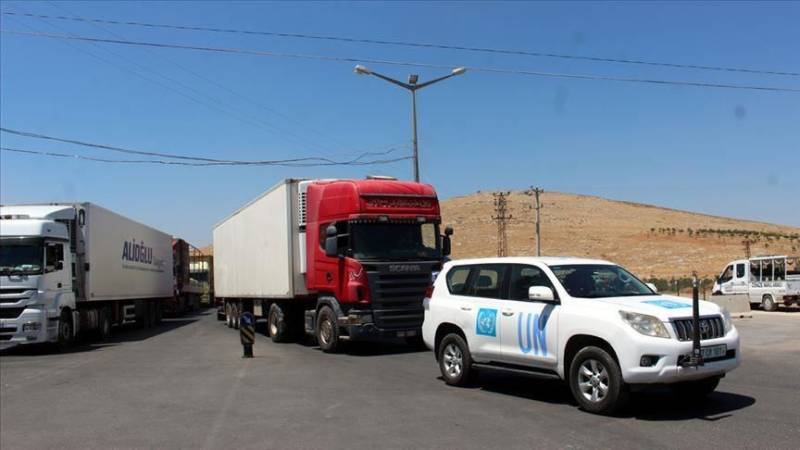The UN on Monday sent 103 truckloads of humanitarian aid to northwestern Syria, where millions of people are in need of assistance due to internal conflict in the country.
The trucks carrying supplies entered Idlib, Syria through the Cilvegozu border gate in Turkey’s southern Hatay province.
The aid will be distributed to residents of Idlib and nearby rural areas.
Syria has been ravaged by a civil war since early 2011, when the Assad regime cracked down on pro-democracy protesters.
Hundreds of thousands of people have been killed and more than 10 million displaced, according to UN estimates.
Idlib falls within a de-escalation zone forged under an agreement between Turkey and Russia. The area has been the subject of multiple cease-fire understandings, which have frequently been violated by the Assad regime and its allies.
It is currently home to 4 million civilians, including hundreds of thousands displaced in recent years by regime forces throughout the war-weary country.
Ironically, the armed group called Petroleum Facilities Guards affiliated with Haftar closed oil facilities in Sidra, Ra's Lanuf, Briga, Zueitine, and Hariga just the day before Jan. 18 International Berlin Conference to find solutions to the Libyan crisis.
The oil production activities of Sharara and El-Fil oil wells in the south of the country had been earlier stopped by these groups in February 2019.
According to the Libyan Petroleum Institute, responsible for the extraction, refining, and export of petroleum, the country has the largest oil reserves in the African continent.
Due to the closure of oil wells and restrictions put by pro-Haftar armed groups, the Libyan economy suffered a loss of $5 billion in January 2020.
From 2016-2019, the country has already lost more than $100 billion, as Ibrahim Cadran, an Haftar ally interrupted the oil excavation in the east of the country.
Cadran has formed a group called Petroleum Facilities Guards to prevent the movement of petroleum products from oil fields.
While international energy institutions say that most of Libya’s oil reserves have remained untapped, the conflict has hit extraction of oil from the existing resources.
The country's largest oil and gas facilities, such as Sidra, Ra’s Lanuf, Brega, and Zueitine, are located in the war-torn east of Libya on the Mediterranean coastline.
The production in the area accounts for 60% of oil exports in the country.
Oil lifeline for the Libyan economy
The Sidra refinery can produce 350,000 barrels of oil every day. The daily production capacities of other refineries like Ra’s Lanuf are 220,000 Zueitine 100,000 and Briga 8,000 thousand barrels.
Since the discovery of oil in the second half of the 19th-century oil revenues have been the lifeline of Libya's economy.
Libya's hydrocarbon resources used to meet the demand of around 70% of national expenditure. AS much as 93 % of the government revenues and more than 90 % of exports were met by oil revenue until Muammar Gaddafi regime was overthrown in 2011.
In 1970, Gaddafi had moved Libyan Petroleum Institution from the eastern town of Benghazi to the capital Tripoli in the west of the country. It reduced the influence of eastern regions, which has approximately 80% of the country's oil reserves.
The collapse of the Gaddafi regime allowed the eastern political groups to rally around and take control of the oil sector. Riots erupted against Gaddafi in Benghazi, where people were seething with anger for shifting the petroleum institute.
The country had recorded the production of 1.6 million barrels of oil in 2010, which dropped significantly due to instability and different groups fighting to take control of resources. Finally, Haftar’s militias made the situation much worse in the region.
Since 2014, Haftar’s militias have been targeting the oil fields to strengthen their position in the ongoing war. But the strategy has cost Libyan economy billions of dollars.
According to the Libyan National Petroleum Authority, the interruptions have resulted in affected production of 800,000 barrels per day and a monitory loss of $55 million.
On Jan. 18, the authority had announced the country's economy has lost more than $ 5 billion due to the stoppage of oil supply from the eastern fields known as petrol crescent since the beginning of this year. Since 2016, the country has lost more than $100 billion.
The country’s Central Bank has reduced its reserves to the lowest level in its history to meet the requirements of paying salaries to government employees and basic expenditures on food, health, and education.
The lack of finances has led to severe economic crises in Libya. The country is facing high inflation, depreciation of the local currency, and the rise in public debt.






